Jel Ena: Through the Gates of Anhedonia by Decadence Darling
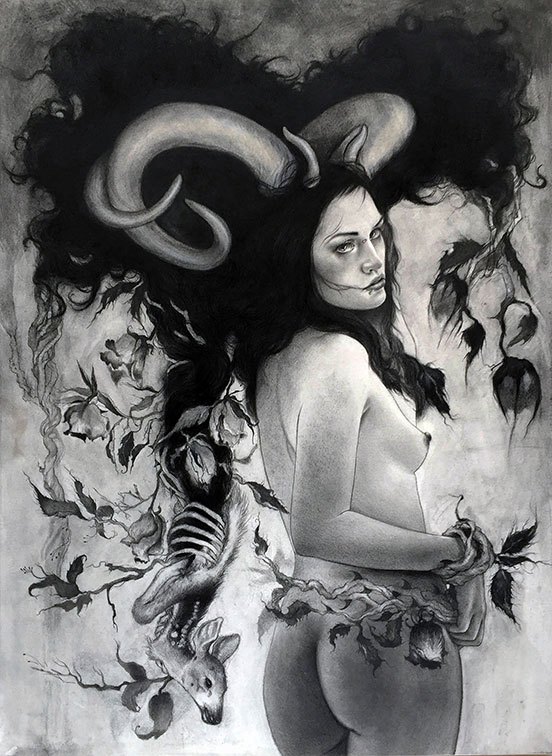
Jel Ena “Sanctum Infernum”, 2015
Jel Ena “Sanctum Infernum”
October 29 – December 15
Stephen Romano Gallery, Brooklyn NY
Jel Ena: Through the Gates of Anhedonia by Decadence Darling
Death is an unknown pleasure. Pleasure is not the addition of something we are without, it is the realization of something that is within. It is through “death” that we awaken this inherent pleasure. When we seek pleasure, small or large, we examine ourselves accordingly. We take inventory, observe patterns, evaluate and assess strengths and weaknesses. Through all of this we judge ourselves. We determine how much of this information we accept or reject. In other words, seeking pleasure is a process of positive acceptance and negative rejection. But what if those things we are adverse to are a part of who we truly are? To dispose of them would make us incomplete. Perhaps in this pursuit of Self we deny our fullness and the thing we wished we were is an empty object full of pain.
Withdrawing from external gratifications is the first step in redefining pain and gaining truth. Anyone who bases pleasure on what is external to themselves would consider such withdraw as painful. This is the womb of melancholy where pain cultivates truth. This is the melancholy gifted to spiritual ascetics. It is this shade of melancholy that resonates through Jel Ena’s Sanctum Infernum.
Pleasure and pain are channeled through the concepts of the sacred (Sanctum) and the profane (Infernum). The sacred and profane are the measurements that we utilize to evaluate our identity and our desires. And unlike the concept of heaven and hell as being isolated spaces strictly divided, the sacred and profane work on a spectrum. But as Jel Ena reveals in Sanctum Infernum, this spectrum is not linear so much as it is circular. As the artist explains,
“It’s a dichotomy of terms; contradiction that is present in all of us, the conflict, and our never ending effort to balance them out. As much as they are contradicting they cannot exist without each other. Just like light cannot exist without darkness, heaven without hell, sacred without profane/infernal.”
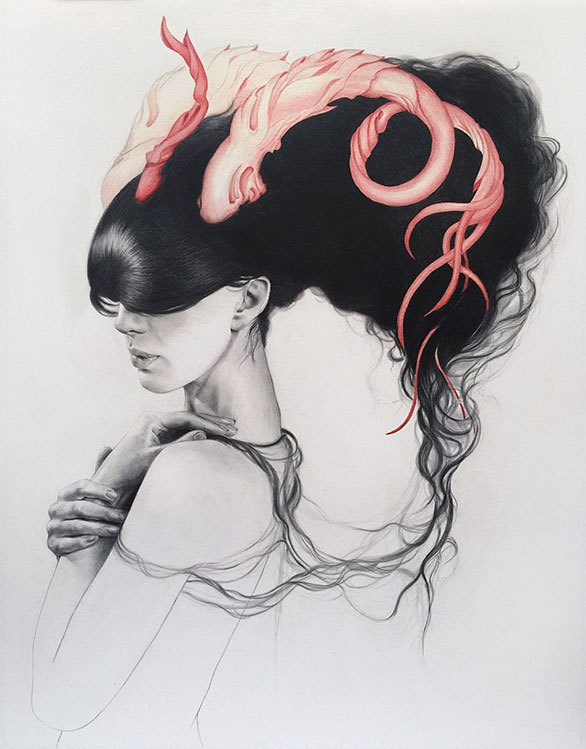
Jel Ena “Praevideat” 2015
In the drawing Sanctum Infernum (above), the woman’s power issues from her head like smoke bellowing from Hell, within which contains the corpse of a deer and dead flowers. Decaying flora and fauna show a process of exiting the light of life and entering the darkness of death. Being intertwined with the decay symbolizes her acceptance of the profane. Death is no more static than life. Death is transformation, breaking down old forms to manifests new forms. Life and death is a cyclic process generating the sacred and profane.
The darkness coming from her head descends upon her, but her power is not whimsical. Her will is concentrated in the form of the horns that protrude from her head. Within this explosion of darkness there appears to be a vulnerability in her stillness. It is the case with all the women in the series. They have not quite assumed their infernal identity. Pleasure is a labor as they struggle with accepting their darkness.
These women are coming from darkness, an infernal place, but they are discovering how strong and powerful they actually are.
The women, who are if not nude, are naked of commitment to the pleasures of the world. These women are powerful, but their power is not displayed in the mood of aggression or dominance. Their power is not stoic, but rather issues from their bodies like a heavy exhalation as tears fill the eyes so that the vision of the world is seen in the texture of their emotions.
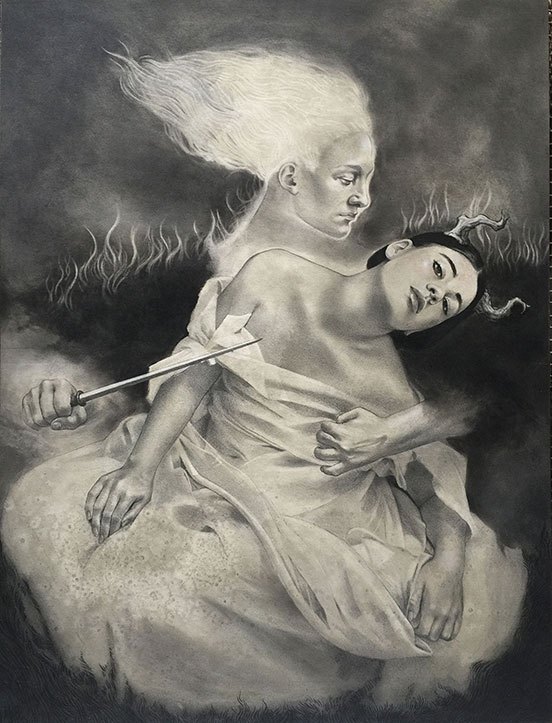
JelEna “Requiem Aeternam” 2015
In Requiem Aeternam a man holds his arm around a woman’s form as his hand grips her chest. Her eyes are in a dead stare, her hands making no effort to resist. Her only motion is that of her body falling to the side allowing her natural force of gravity to counter his egotistical will. He can’t give her the pleasure she is seeking.
This man is no different from any possible object outside of the woman that could be portrayed in the drawing. He is irrelevant, therefore atmosphere is irrelevant, almost irrelevant. Light and darkness are the only significant ambient details as they complement the emotional context within the subject that cannot be realistically drawn. There is no organic atmosphere, and yet everything is naturalistic. The form of the woman does not become enveloped in darkness, rather she becomes enlightened. It is her greatest darkness that illuminates her greatest light.
Their forms are in some way idealized on purpose in order to juxtapose overall dark and grotesque mood. Their bodies are an epitome of light existing amidst the darkness.
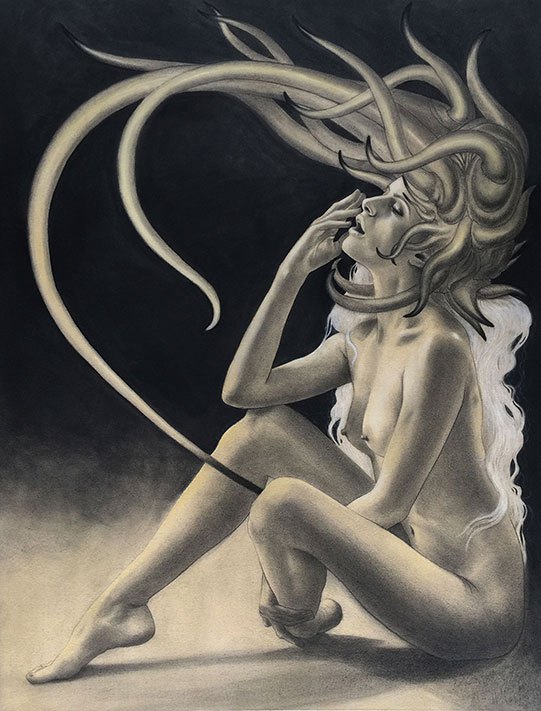
Jel Ena “Immaculatam Conceptionem” 2015
Immaculatam Conceptionem explores this connection of power and pleasure through the masturbatory act where the woman’s own horns creates a sort of Ouroboros of pleasure. The energy that comes from the lowest parts of the body ascends and culminates into a degree of concentrated power that takes the form of horns. But this is not a narrative of transcendence where that power would continue directing upward to the heavens and connect with the Divine. Instead, the horns are directed downward and are invested back to the lower chakra where that energy is released, only to eventually rise back up creating a cyclic continuum of the sacred and profane.
Despite this image of completion this woman is alone. All of these women are alone. Even in Salve Me, surrender appears to come down with closed eyes. Clothes fall open, exposing both breasts of the upper woman. Her hand gently touches the other woman, but does not grip. It is this uncertainty that is throughout the series. Each form is open but hesitant by guarding their core by an arm across their chest, or a back turned, or a body lying on the floor or falling to the ground.
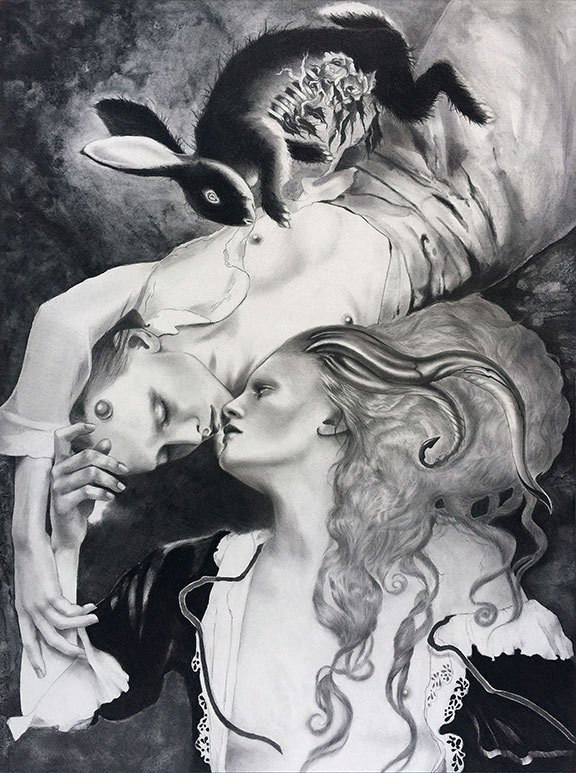
Jel Ena “Salve Me Fons Pietatis” 2015
It is their environment, it is the negative and positive energies, feelings, emotions they are battling to balance out. I don’t believe in surrender.
The paradox of the isolated death in which these women exude power is that the darkness in which they have empowered themselves requires them to project their power. Because darkness and death are cyclical it is inevitable that as much as these women stand empowered in the profane, they must also be empowered within the sacred. The counterpoint of pleasure is sacrifice. Whereas pleasure seemingly intakes, sacrifice projects. But sacrifice is another death experience, and it is through death that one again achieves pleasure.
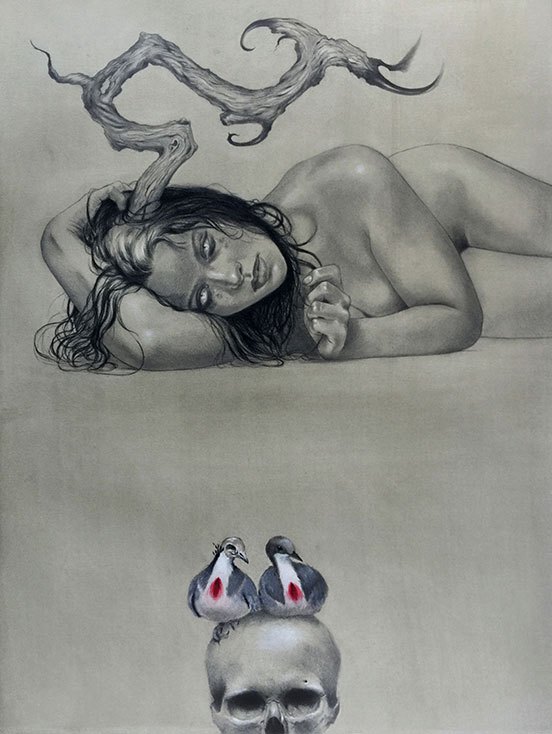
Jel Ena “Stigmata”
Sacrifice is the coalescence of the sacred and profane, but it requires acceptance of oneself in order to sacrifice that thing. We cannot give what we do not have—and what are we to give that someone does not inherently have within them? This is the mystery in sacrifice and surrender. In Stigmata the woman lies down, she does not stand. It appears that she is not situated in her power. She is gazing upon a skull of another. Reaching out and meditating on the skull, upon which two wounded Luzon doves are perched, implies her struggle to find salvation outside of herself. The mystery of stigmata is that through one’s salvation they become the sacrificed. Even if connected to the Divine it is in isolation that we experience redemption. This is not the only story of sacrifice in the series.
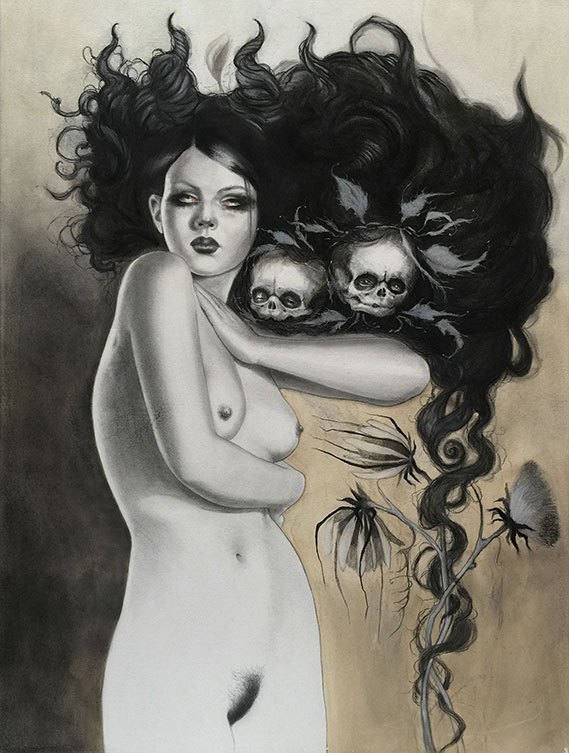
Jel Ena “Medea” 2015
The drawing Medea depicts the classical story of Medea who sacrificed her own children to spite Jason for his betrayal. Unlike Stigmata where the woman struggles with salvation by adding something from outside of herself, Medea has subtracted something external to herself. She does not depend on another to receive what is already hers. She stands frontal, however, her shoulder blocks us from fully receiving her form. Though she has liberated herself she carries a burden that anchors her to one moment in time, thus continuing with the circular model of the sacred and profane being the seeds of each other’s manifestation.
Death, darkness, isolation, sacrifice, and the infernal are the things we generally fear, but these very elements can be the ingredients to our greatest power. In isolation we can separate our true self from misidentifying with illusion. In darkness we can find hidden strengths. In sacrifice we embrace what cannot be given or taken. In death we transform. In the infernal we find empowerment. Sanctum Infernum is not a perversion of the sacred, nor does it define pleasure as base pleasures easily obtained by the removal of moral or ethical barriers. Sanctum Infernum is the pleasure that is discovered when all pleasure has died. It is through the death of pleasure that one becomes satisfied. Pleasure is the sacred, the unknown is the profane, and death is the ring upon which they continuously spin. The pain we once feared is the very key that unlocks an equal pleasure, and our sense of empowerment. Rather than our lives being a reaction to an inevitable death, we can take actions that uses death as an instrument of illumination in our life.
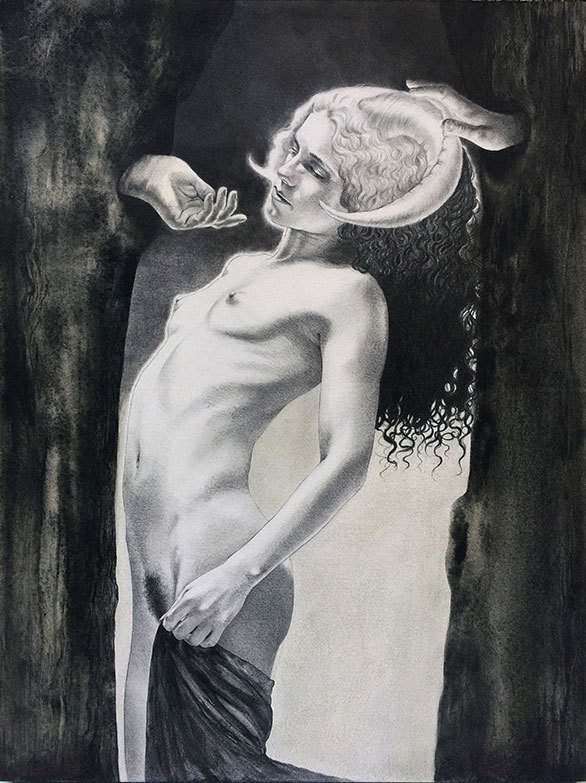
Jel Ena “Lux AbIntus” 2015
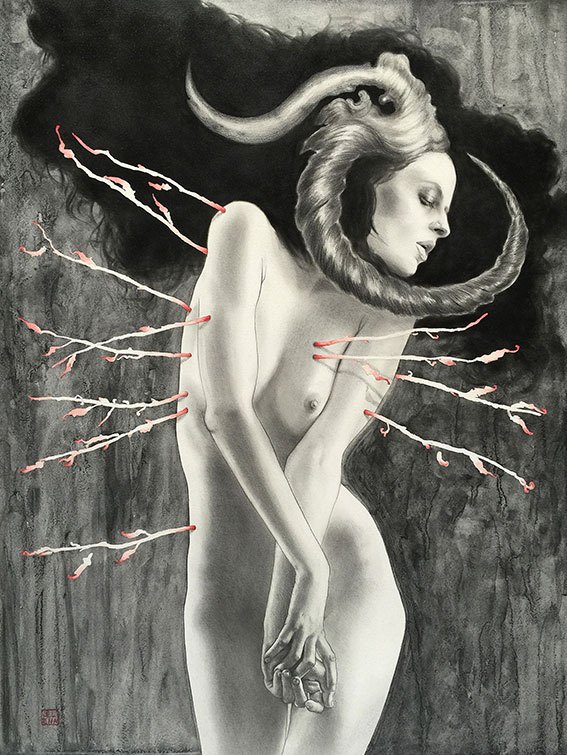
Jel Ena “Lubido”
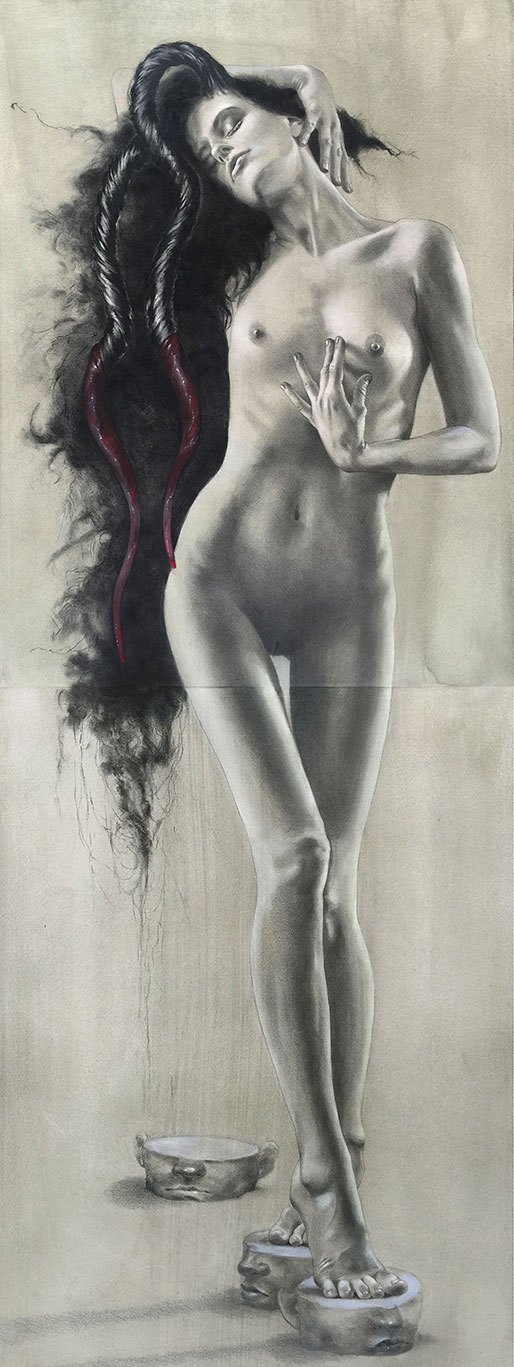
Jel Ena “Carpe Diem” 2015
Jel Ena “Sanctum Infernum”
October 29 – December 15
Stephen Romano Gallery, Brooklyn NY
